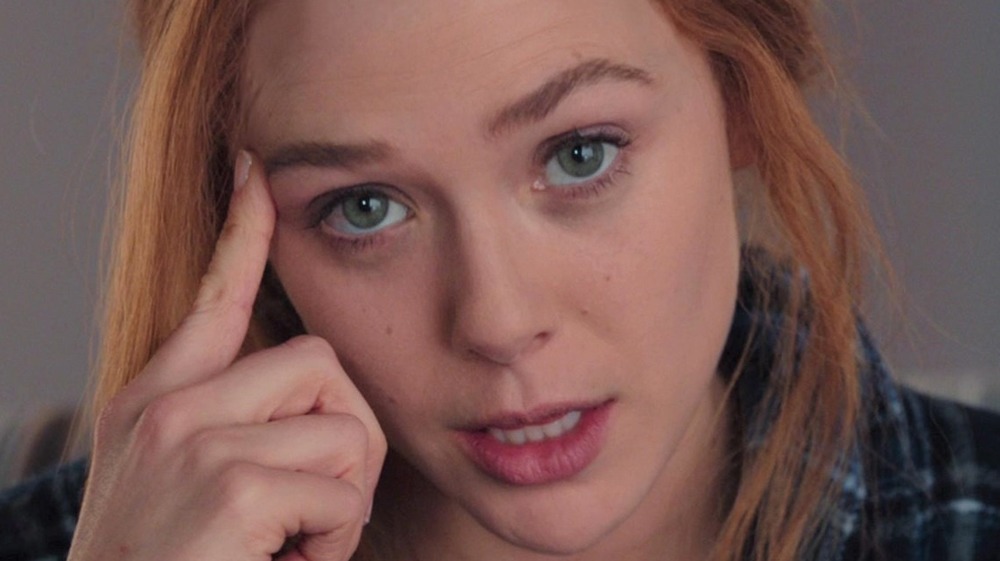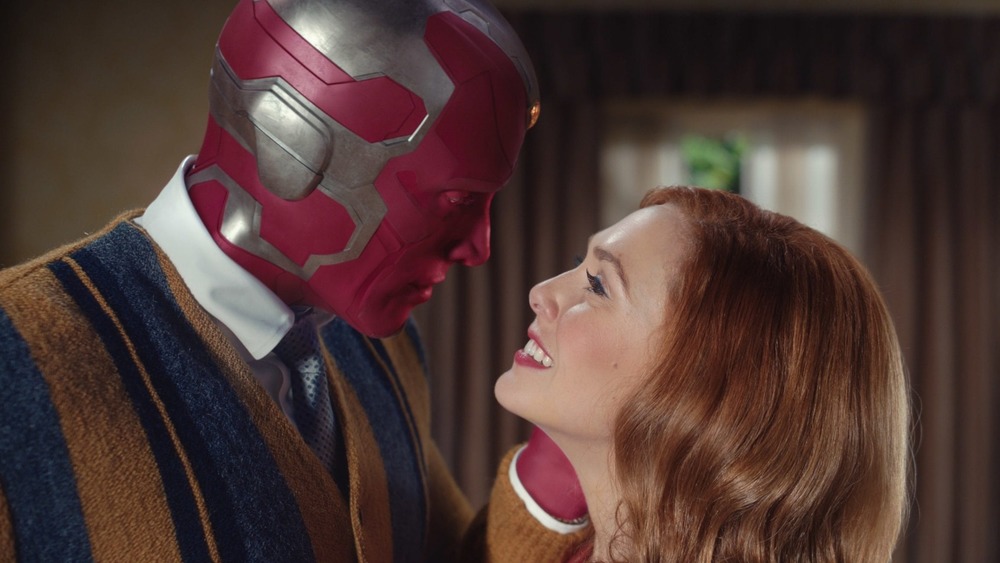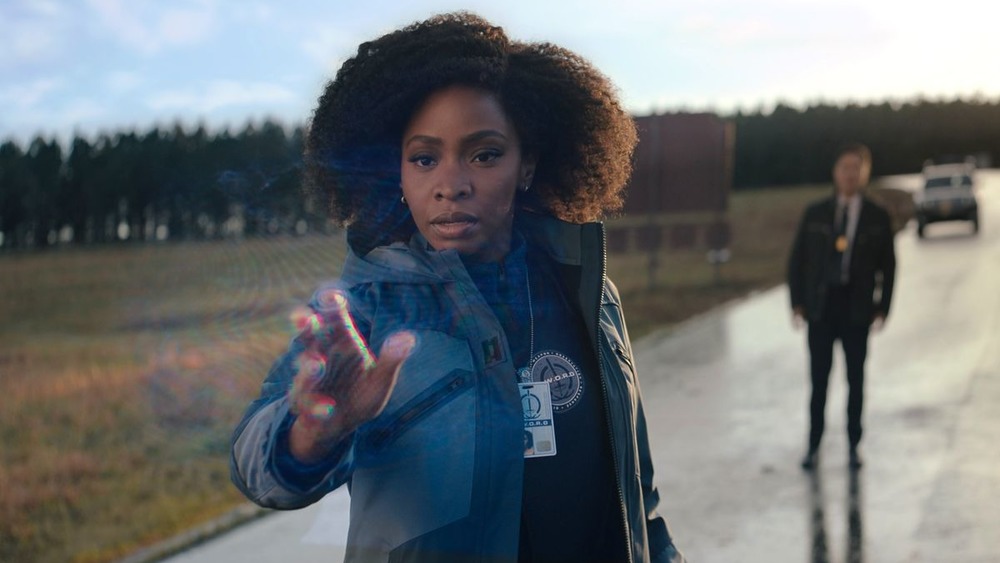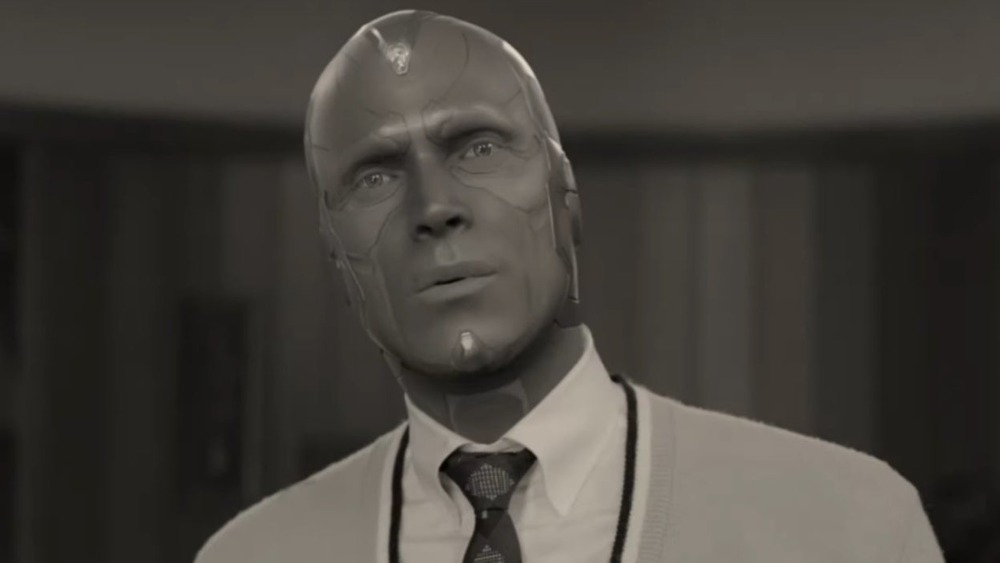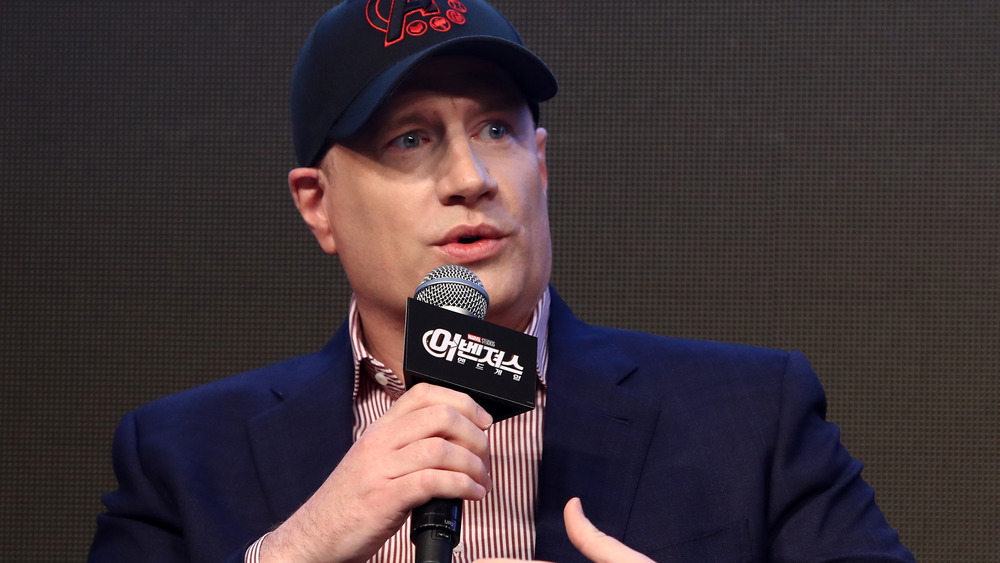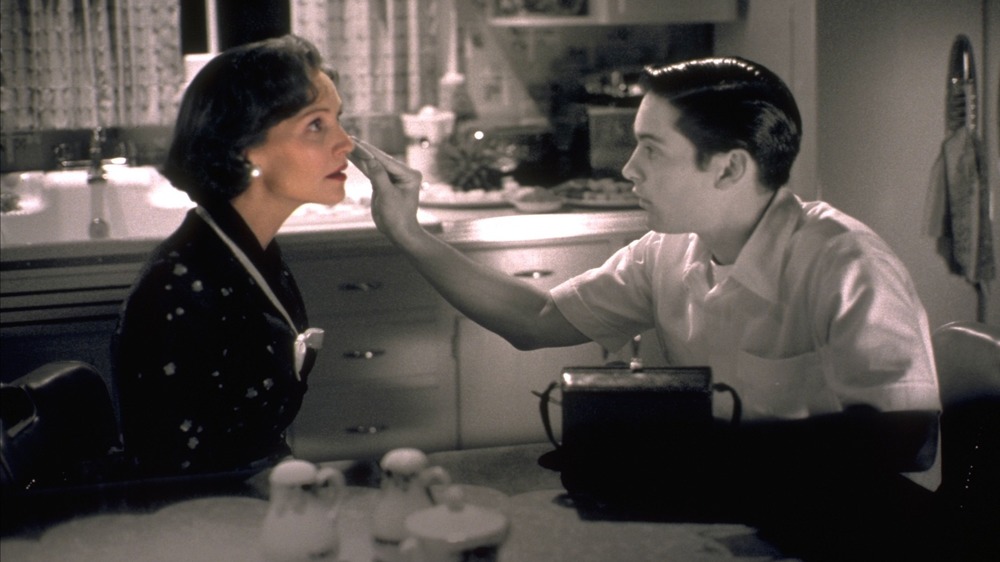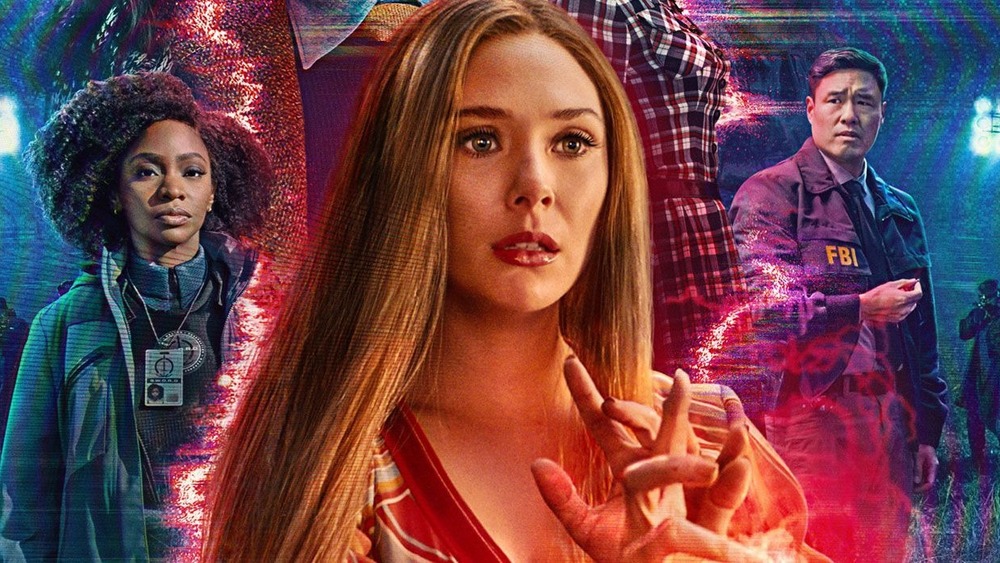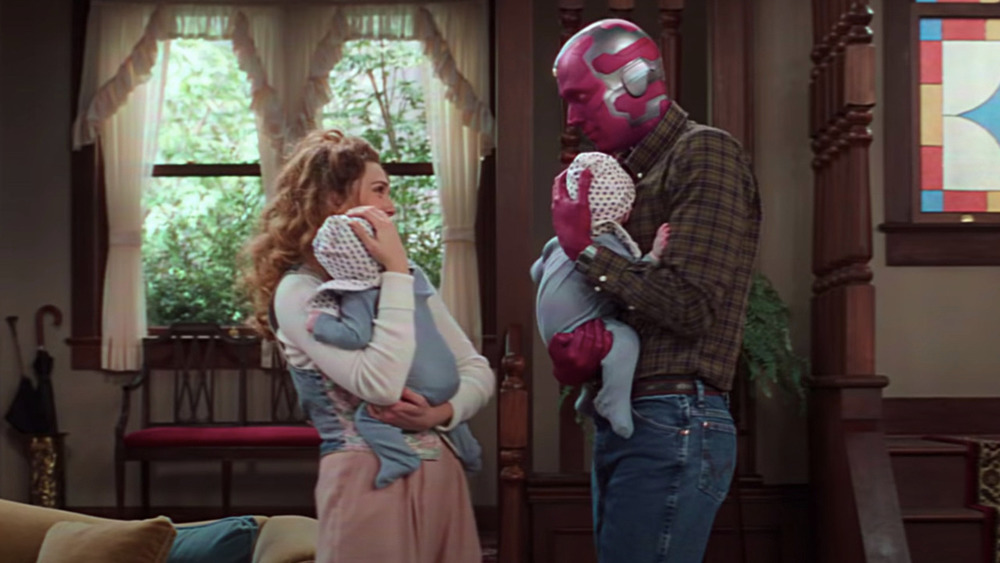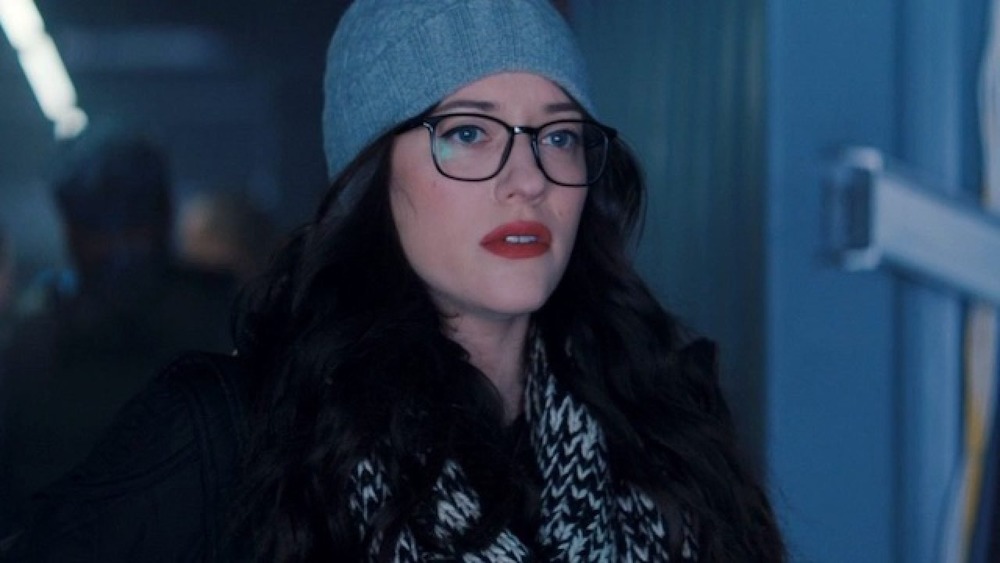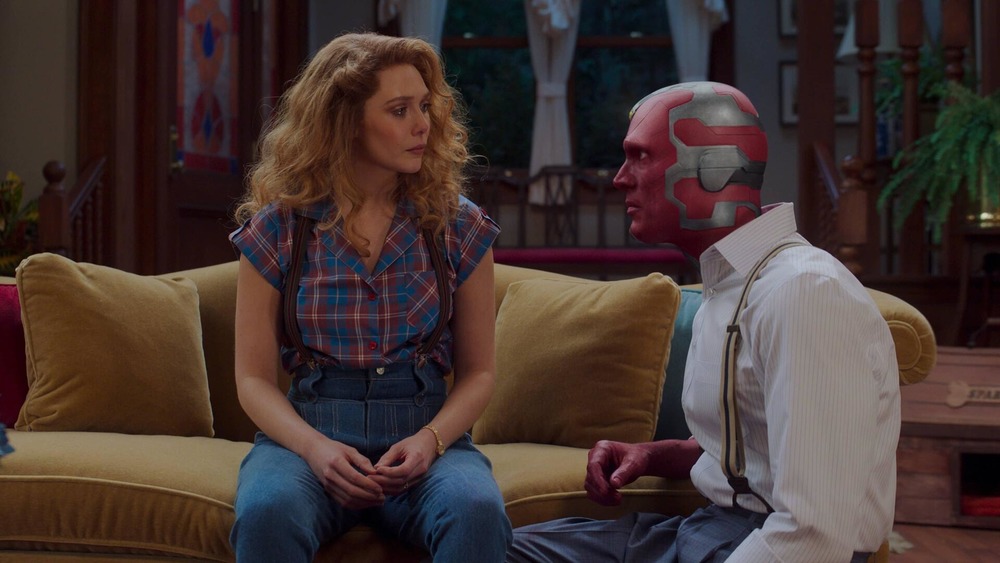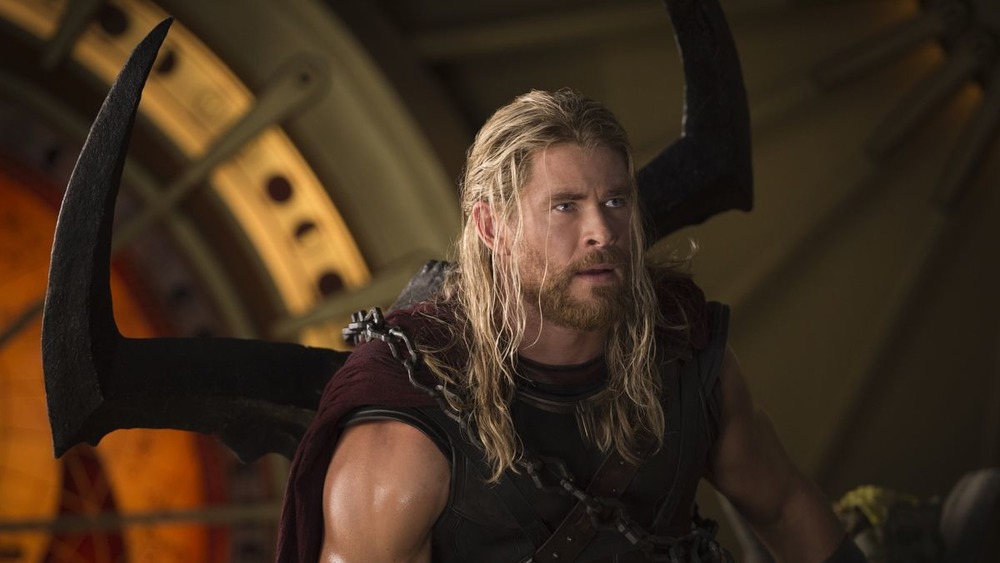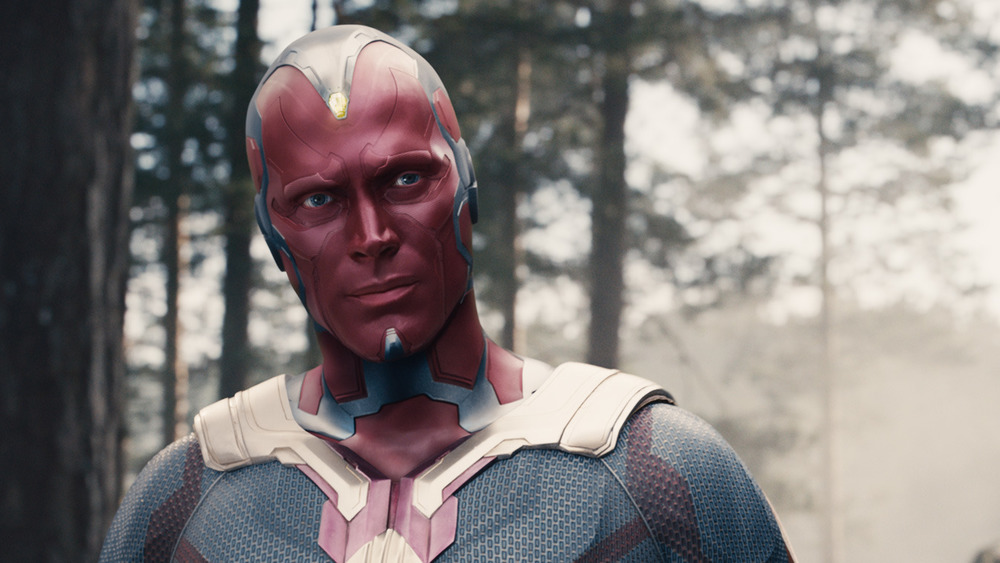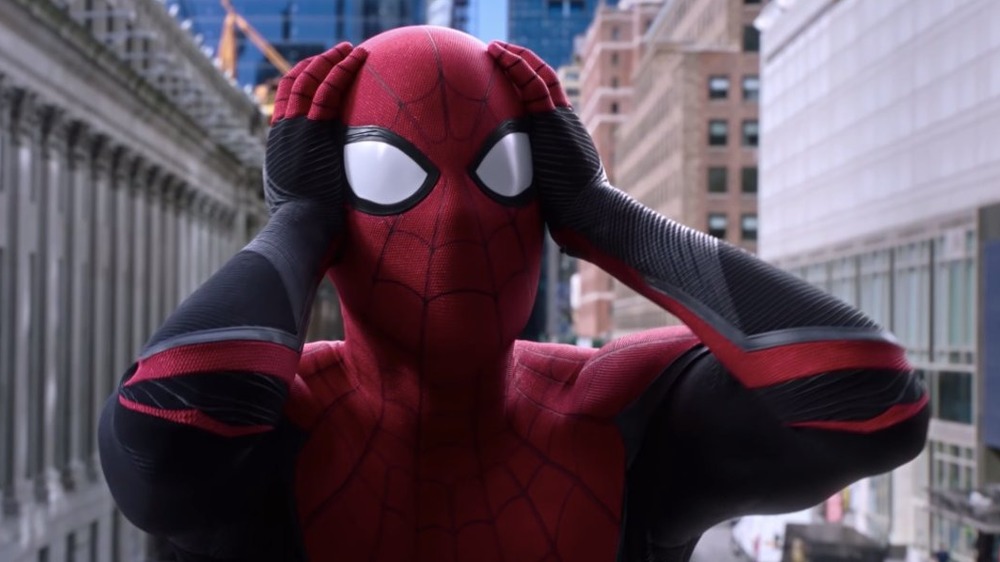The Untold Truth Of WandaVision
WandaVision is all about mysteries. Why are Wanda Maximoff and Vision trapped in various classic sitcoms? What are Taylor Hayward's actual goals? Is there someone secretly pulling all the strings? The show has been littered with an uncertainty that's kept viewers on the edge of their seats for weeks on end. However, all the intrigue related to WandaVision isn't just limited to what's happening on-screen. Behind the scenes, the show's production is rife with nifty details that help explain the level of craft, detail, and thought that went into creating a whole new corner of the Marvel Cinematic Universe.
Thanks to how MCU projects are shrouded in secrecy, these details haven't become common knowledge. That helps to keep spoilers from spilling out, but it also means the finer intricacies about WandaVision's behind-the-scenes wizardry haven't been fully appreciated. However, now is the perfect time to become more acquainted with the lesser-known elements about WandaVision that played a pivotal role in shaping the show into 2021's first television obsession.
(Warning — there are major spoilers below.)
WandaVision is Marvel Studios' first foray into television
Marvel has been dominating television for decades. Dating back to the days of the 1960s Spider-Man cartoon and Bill Bixby's Incredible Hulk show, it's been more common to see the spandex-clad Marvel characters on the small screen than it is to see them on the big screen. But until WandaVision, those TV shows didn't hail from Marvel Studios, the outfit responsible for the movies in the Marvel Cinematic Universe.
For decades, Marvel licensed their characters in film and television out to other studios. That all changed in 2010, when Marvel started their own standalone division, Marvel Television, to tackle small-screen outings for their characters. The likes of Agents of S.H.I.E.L.D. and Daredevil were just a few instances of the shows produced by Marvel Television. But despite scoring a number of successes, Marvel Television was shut down in 2019, resulting in the demise of countless popular programs, as well as unmade series like an animated Howard the Duck show.
It was a seismic shift that came about due to the company's focus on television shifting over to Marvel Studios producing programs for the Disney+ streaming service. The first show in that initiative? WandaVision, which served as the program that would kick off a new era in Marvel's long history of television.
Monica Rambeau wasn't always supposed to be in the show
Over the course of WandaVision, a grown-up Monica Rambeau (who was first glimpsed as a child in Captain Marvel) has become a fan-favorite character, particularly once she got her superpowers in the show's seventh episode. In addition to being entertaining, Rambeau has also become somebody who's proven important to the overall plot of WandaVision. In particular, her internal struggle with missing the death of her mom has served as an effective parallel to Wanda Maximoff's own struggle with grief. Rambeau is a manifestation of hope that Wanda can work through her own pain, that there's a path to coping beyond just getting lost in sitcoms.
Given her long list of accomplishments in the show, as well as all the praise she's received, it can be surprising to realize that Rambeau wasn't always supposed to be in WandaVision. When showrunner Jac Schaeffer first pitched the series, Monica was nowhere to be seen. "There was a character like Monica; she served the purpose of Monica in my pitch," Schaeffer explained to Screen Rant. "But it was a later discovery that we could use Monica Rambeau for that character. And that was so exciting when we put those pieces together." Monica Rambeau may not have always been a part of WandaVision, but viewers everywhere would agree that it's now impossible to imagine the show existing without her.
WandaVision was shot (partially) in front of a live studio audience
WandaVision wouldn't be a classic sitcom if it wasn't at least partially filmed in front of a live studio audience. While later episodes of the show would employ an artificial laugh track, an authentic version of that element would have to be utilized at least partially. Thus, the producers of the show decided to film WandaVision's initial episode, evoking sitcoms of the 1950s, in front of actual people. Needless to say, capturing Wanda Maximoff and Vision on a small stage in front of an audience was a massive departure from the traditional filming style of MCU properties that orient around closed-off soundstages.
But filming the show in this manner didn't just add further authenticity to the retro-vibe of WandaVision's earliest episodes. It also brought out the best in the actors themselves, as one of the audience members, WandaVision lead Teyonah Parris, can attest. As Parris explained to TVLine, "I got to take a little 'cheat day' and absorb it all and watch my amazing castmates, Lizzie [Olsen] and Paul [Bettany] and Kathryn [Hahn], kill it. And then I jumped in with them a little later." WandaVision has many unique qualities, but perhaps its most distinctive element is how it went to such lengths to emulate those vintage sitcoms.
The original idea came from Kevin Feige
The Marvel Cinematic Universe couldn't be brought to life without the talents of many artists, from the filmmakers tasked with directing individual films to staples of the franchise like casting director Sarah Halley Finn. But there's no denying that Marvel Studios Chief Creative Officer Kevin Feige is a key creative voice in the sprawling enterprise. His influence was particularly felt with WandaVision, as he came up with the initial concept of creating a sitcom that would take the characters of Wanda Maximoff and Vision and plop them into suburbia.
Not only was Feige taking cues from earlier comic runs featuring the two characters (namely House of M and The Vision), he was also inspired by his own love of sitcoms. Feige was apparently a Nick at Nite fan growing up and that love has seeped into his creative pursuits at Marvel Studios. "I kept thinking of how influential these programs were on our society and on myself," Feige explained to Entertainment Weekly, "and how certainly I was using it as an escape from reality where things could be tied up in a nice bow in 30 minutes."
Combining sitcoms with two Avengers was a risky idea. It's certainly not something one would initially imagine as one of the direct follow-up projects to Avengers: Endgame. However, it's one of the many unusual ideas that Feige has managed to spin into gold during his time at Marvel Studios.
WandaVision drew inspiration from two '90s classics
Watching WandaVision, it becomes readily apparent which TV shows certain episodes take cues from. The first episode wears its Dick Van Dyke Show homages on its sleeve, while a later episode features a staircase that could only have come from The Brady Bunch. As a love letter to sitcoms, WandaVision has no shortage of nods to classic pieces of television programming. However, movies have also provided creative inspiration for the production and not just big-screen entries in the Marvel Cinematic Universe.
In talking about how the series tackled unique visual traits, WandaVision director Matt Shakman revealed that two films from the 1990s that grappled with 20th-century suburbia and television had a great deal of influence on this Marvel TV show. When asked if Pleasantville and The Truman Show had any sort of impact on WandaVision, Shakman told The Hollywood Reporter, "Absolutely. ... I love both of them. I think that there's some spiritual connection to both films, of course."
Pleasantville especially had an obvious impact on WandaVision given how that movie also explored black-and-white 1950s sitcom but with an eerie touch that emphasized how divorced from reality these programs were. And that's not the only connection WandaVision has with Pleasantville. Both this MCU program and that Gary Ross film share a prop designer, Russell Bobbitt, who helped ensure that both projects got the tiniest details of their TV worlds just right.
Some filming took place during the pandemic
The MCU may be a pop culture juggernaut, but even it couldn't avoid being impacted by the COVID-19 pandemic. Every project in the works at Marvel Studios was delayed by the health crisis, with their entire movie schedule getting delayed over a year. And WandaVision was no exception to this phenomenon. The show got nearly four months of filming under its belt before principal photography was shut down due to the pandemic.
As recalled by director Matt Shakman to The Hollywood Reporter, the timing on this whole matter was peculiar. "We were shut down at a really interesting moment," Shakman explained, "because we had just wrapped in Atlanta, and we had moved to L.A. So we were about ready to start shooting the next chunk of our schedule, which was all about shooting on backlots." That specific slice of WandaVision's principal photography took months to resume, and it wouldn't be until the fall of 2020 that things cleared up enough for the MCU program to return to its sitcom shenanigans.
However, the ongoing presence of COVID-19 meant that things weren't the same on set. Extreme precautions were put into place to keep the cast and crew safe while the show was finally wrapped up in November 2020. WandaVision might have been able to get weeks of filming done during a worldwide pandemic, but its six-month hiatus is a testament to how even massively expensive TV shows aren't impervious to being affected by COVID-19.
The magic behind those aspect ratio changes
WandaVision employs a number of visual tricks to help clarify the differences between the sitcom world inside the Hex and the real world outside. Beyond the use of period-era costumes and black-and-white photography, one notable visual trait is the employment of ever-shifting aspect ratios.
Different aspect ratios, such as 4:3, are used for the different eras of television that take place inside the Hex. The on-screen visuals are bending to the wills of classic television as a way of reflecting how much control Wanda has over her reality. Meanwhile a 2.40:1 aspect ratio is utilized for scenes that are supposed to remind the viewer that they're watching something firmly rooted in reality, such as everything happening at S.W.O.R.D.'s compound or in Agatha's basement.
It's one of the most thoughtfully rendered qualities in WandaVision's journey between reality and another realm dictated by the will of Wanda. And scenes where the aspect ratio changes on-screen — rather than in between shots — were accomplished through post-production magic. "Ultimately, the transition is done in post-production," cinematographer Jess Hall said to Collider, "because the timing of it is very specific, and Matt Shakman, our director, will have a point of view on exactly how long he wants it to last, how quickly the dropdown comes, and so on."
Hall also noted that another crucial element of the 2.40:1 aspect ratio is that it's meant to evoke the look of traditional MCU movies. This level of thought makes the shifting aspect ratios of WandaVision glorious to behold.
Kat Dennings was surprised to return to the MCU
Kat Dennings entered the Marvel Cinematic Universe with the franchise's fourth entry, the first Thor movie. Playing the role of Jane Foster's intern, Darcy Lewis, Dennings provided levity as an original character created for the MCU. She reprised the role in Thor: The Dark World, where she now had her own intern, but that was the end of her story for a moment. She subsequently vanished from the series, and it wasn't hard to see why. The next Thor movie, Ragnarok, shifted things largely to outer space, and more importantly, it depicted Thor and Foster as having broken up. This meant there wasn't any room for Foster's intern, Darcy, to show up in the Thor movies anymore.
It appeared the book was closed on Darcy, and that perception wasn't just shared by fans. Apparently, until WandaVision came along, Dennings was convinced that there wouldn't be any further opportunities for her to appear in the series. "That call was very unexpected," Dennings said to Entertainment Weekly about the offer to reprise the role of Darcy on WandaVision, "and, of course, I was delighted to be asked. I am just a big fan of Marvel in general. I had no expectations of ever coming back, so I was just thrilled."
The devil is in the (period-era) details
The Marvel Cinematic Universe has tackled period projects before with films like Captain America: The First Avenger and Captain Marvel. But for WandaVision, a unique challenge was presented in that this show wasn't just a period piece but several period pieces at once. Since multiple decades would be explored in individual episodes, the production would have to bring its A-game in terms of replicating the tiniest period-era details so that everything didn't just begin to blend together. If that happened, the whole series, which hinges on homages to classic sitcoms, would crumble.
With all that pressure on, getting all those finer points of the past right, as director Matt Shakman explained it, was a comprehensive task. "We recreated everything from vintage lenses, production and costume design, to the actors getting together with me and studying what those old shows looked like," Shakman explained to The Hollywood Reporter. "We tried to put our finger on what comedy was like back in the '50s versus the '60s, because it really does change. ... It was really important because ultimately this is the reality of that episode, and we wanted people to fully buy into it."
Going the extra mile in every department — they even brought in a dialect coach to nail the voices of each decade — paid off. Rather than just doing surface-level pastiches, WandaVision took the MCU's ability to do period pieces to a whole new level, earning praise from fans and critics alike.
How Thor: Ragnarok paved the way for WandaVision
WandaVision has been praised for its ability to go weird and creepy without winking to the audience. It's a tone that hasn't really been explored in previous Marvel Cinematic Universe properties, which have largely avoided going in an eerie direction. Though it's widely seen as a groundbreaking trait of the program, WandaVision showrunner Jac Schaeffer doesn't see the program's aesthetic as totally unprecedented. In fact, she's attributed the show's unique aesthetic to a prior creative endeavor in the MCU, Thor: Ragnarok.
Like WandaVision, Thor: Ragnarok was widely praised for injecting some distinctive weirdness to a mainstream superhero franchise. Things like a kindly Kiwi rock monster or an ending where Asgard needed to be destroyed weren't standard MCU fixtures. Instead, they reflected the bold creative spirit of its writer/director, Taika Waititi. Those kind of creative swings emboldened Schaeffer.
"That was really the movie, for me, that broke my brain," Schaeffer remarked on Ragnarok to IndieWire. "I thought it was just so daring and so exciting. Smashing the mold and taking all the colors and throwing them around." Schaeffer even noted that she was surprised WandaVision was seen as so groundbreaking because of how much it owed to Thor: Ragnarok. Waititi's first MCU romp may have been ultra-silly, but its creative bravura was clearly influential in helping to shape WandaVision.
Paul Bettany never thought he'd play Vision again
By the end of Avengers: Infinity War, Vision hasn't just ended up dead — he's had his head ripped open by Thanos. It's a gruesome moment that seemed to put an end to Vision's exploits in the MCU, especially after the character didn't return for the big blowout adventure in Avengers: Endgame. Even Vision actor Paul Bettany never thought he'd get to play the character again, let alone as one of the lead characters of a big TV show like WandaVision.
The seemingly deceased state of Vision was fresh on Bettany's mind when he went to the meeting where he was pitched the idea of headlining WandaVision. "I was called in to see Kevin [Feige] and [Marvel co-president] Louis D'Esposito and was convinced that they were going to be gentlemen and say, 'It's been a great ride; thank you for your work and good luck,'" Bettany explained to Emmy. That, of course, isn't what happened, and once Bettany was informed of what the future held for Vision, "I said I was in." Though Vision seemed to be down for the count by the end of Infinity War, as WandaVision has constantly shown, the unexpected can sometimes be right around the corner.
WandaVision sets up multiple Marvel movies
When WandaVision was first announced at the San Diego Comic-Con, it was revealed alongside the news that Elizabeth Olsen would be reprising her role as Wanda Maximoff in Doctor Strange in the Multiverse of Madness. While it wasn't clear what kind of part she'd play in that blockbuster, since that announcement, it's been apparent that WandaVision would be helping to establish Doctor Strange's second solo adventure. However, it now appears that it's not the only upcoming MCU movie the show is helping to set up.
In an interview with ComicBook.com, WandaVision director Matt Shakman revealed that he'd been coordinating with other MCU productions to make sure his TV series fit into the larger MCU canvas. Two MCU directors he'd been in particularly close contact with were Multiverse of Madness helmer Sam Raimi and Spider-Man: No Way Home director Jon Watts. "It's a relay race, this whole thing," Shakman explained. "And so you're passing the baton from one group of filmmakers to another, and you want to make sure ... that handoff ... is effortless and perfect, right."
Given that no cast members from No Way Home have appeared in WandaVision thus far, it's currently unclear how it connects to the next Spider-Man movie. Perhaps it'll connect by way of those rumored multiverse shenanigans the web-crawler will supposedly engage in. Whatever the connection ends up being, it's just one of numerous ways WandaVision is connected to the larger MCU.
